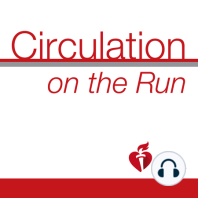16 min listen

Circulation on the Run and Discover CircRes Dual Podcast with Dr Joseph Hill, Dr. Jane Freedman, and Dr. Amit Khera
Circulation on the Run and Discover CircRes Dual Podcast with Dr Joseph Hill, Dr. Jane Freedman, and Dr. Amit Khera
ratings:
Length:
10 minutes
Released:
Dec 23, 2019
Format:
Podcast episode
Description
Dr Amit Khera: I'm Amit Khera, I'm digital strategies editor for Circulation and I'm standing in this week for Carolyn Lam and Greg Hunley. And I'm also doing the Circulation on the Run podcast, as well as Discover CircRes podcast with our two editors in chief. This is Jane Freedman, who recently took over as editor-in-chief of Circulation Research, and Joseph Hill, who is the editor-in-chief of Circulation. So, welcome you both. We're excited to do this. Dr Joseph Hill: Thank you. Dr Jane Freedman: Thank you. Dr Amit Khera: The idea behind this, there's this session here at sessions where we're learning a little bit about Circulation Research and Circulation, pulling back the cover, if you will, and seeing behind the cloak, as what happens in the Journal. So, Dr Freedman, I'll start with you. Tell me a little bit about, as the incoming editor of Circulation Research, some of your vision for the Journal, which you're excited about. Dr Jane Freedman: Mm-hmm (affirmative). Well, I'm thrilled to be the new editor of Circulation Research. And I've assembled a fabulous team of associate editors, deputy editors and other staff and support, that are going to continue to grow what's already a wonderful journal, to be the preeminent and primary journal for basic and translational cardiovascular sciences. And also support and interact with the other HA family of Journals. Dr Amit Khera: So obviously that starts with a great team. And it sounds like you've assembled that. Anything new that you're thinking about, and sort of the redesign of Circ Research in your term? Dr Jane Freedman: Sure. So, we're hoping to expand the original scientific content, so we can have a larger number of articles in original science. And we can have the pages to be able to handle other areas of basic cardiovascular science to include new areas, emerging areas, things like that. We're also increasing some of our early career initiatives, so that's very important to us as well. Dr Amit Khera: Fantastic. Fantastic. Can you talk about expanding for science? And Joe, that leads to you. I'm going to, in this session tomorrow, one of the goals is when people submit their science, it really goes into a black box and people don't know what happens on the editorial level. Can you maybe enlighten us a little, what happened? Dr Joseph Hill: Jane and I have been friends for 20 or more years and we now have established a bi-directional, mutually synergistic collaboration where we send papers each way. We have distinct missions, but yet with significant overlap. And I think it's an incredibly exciting time for the entire portfolio of AHA Journals. So as you say, most people that you hit send and you wait four to six weeks, and you either get a happy note or an unhappy note. And, what happens at both our Journals is we have a strategy of multiple touches on every paper. The paper that first comes in, is first touched by a senior editor, either myself or James de Lemos, and two or three others. And we will reject without review, about 50% of the papers at that point. We publish six papers a week, but we get 110 a week. So we don't need to review 50 of them to pick the top six. Out of respect to our authors to save them time, out of respect to our reviewers who devote tremendous effort to reviewing papers, we don't send them papers that we don't think have a shot. That said, if a paper makes it past that first stage, there's about a 50% chance it'll get published either in our Journal, or in one of the subspecialty journals. Probably a 50-50 chance it'll be published somewhere in an AHA family Journal. So if it makes it past that stage, we send it to an associate editor, of which you are one. And we have about 50 of them. A third are in Dallas, another third are in the U.S. outside of Dallas, and another third are in countries around the world, 17 different countries. And that person will probably reject without review, another five or 10% maybe. But he or she will dig into th
Released:
Dec 23, 2019
Format:
Podcast episode
Titles in the series (100)
Circulation June 6, 2017 Issue: Circulation Weekly: Your Weekly Summary & Backstage Pass To The Journal by Circulation on the Run